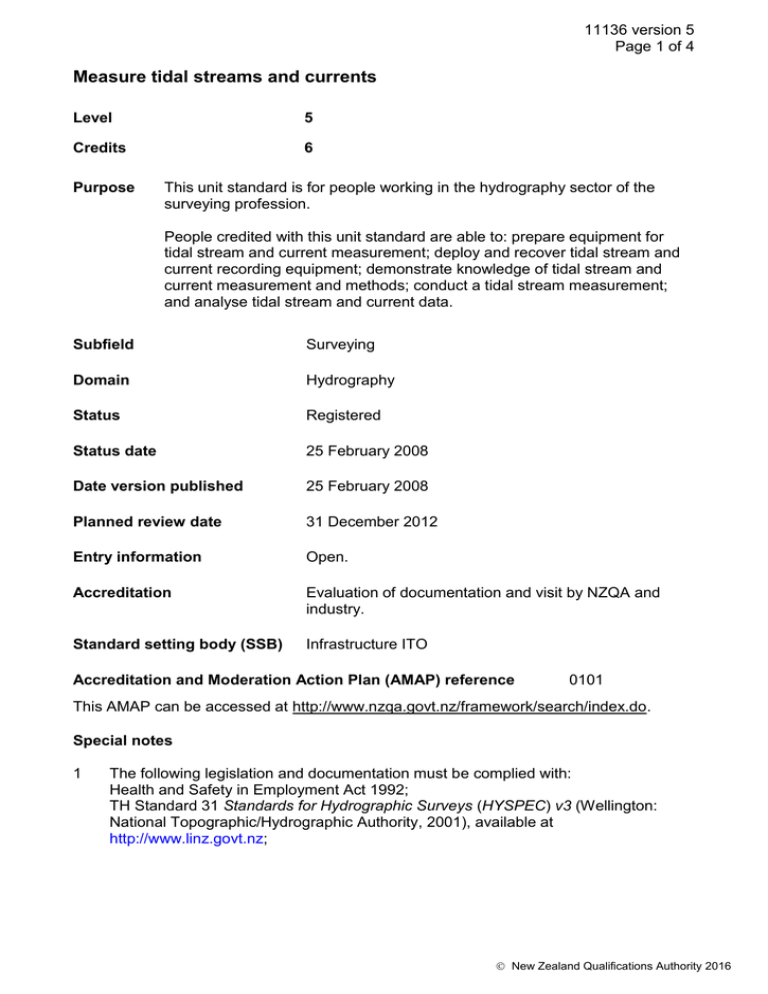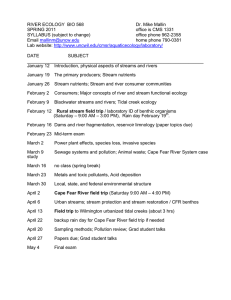Measure tidal streams and currents
advertisement

11136 version 5 Page 1 of 4 Measure tidal streams and currents Level 5 Credits 6 Purpose This unit standard is for people working in the hydrography sector of the surveying profession. People credited with this unit standard are able to: prepare equipment for tidal stream and current measurement; deploy and recover tidal stream and current recording equipment; demonstrate knowledge of tidal stream and current measurement and methods; conduct a tidal stream measurement; and analyse tidal stream and current data. Subfield Surveying Domain Hydrography Status Registered Status date 25 February 2008 Date version published 25 February 2008 Planned review date 31 December 2012 Entry information Open. Accreditation Evaluation of documentation and visit by NZQA and industry. Standard setting body (SSB) Infrastructure ITO Accreditation and Moderation Action Plan (AMAP) reference 0101 This AMAP can be accessed at http://www.nzqa.govt.nz/framework/search/index.do. Special notes 1 The following legislation and documentation must be complied with: Health and Safety in Employment Act 1992; TH Standard 31 Standards for Hydrographic Surveys (HYSPEC) v3 (Wellington: National Topographic/Hydrographic Authority, 2001), available at http://www.linz.govt.nz; New Zealand Qualifications Authority 2016 11136 version 5 Page 2 of 4 IHO Standards for Hydrographic Surveys, Special Publication No 44 (Monaco: International Hydrographic Organisation, 1998) (IHO standards), available at http://www.iho.shom.fr; Guidelines of Good Practice for Hydrographic Surveys in New Zealand Ports and Harbours (Wellington: Maritime Safety Authority of New Zealand, 2004), available at http://www.msa.govt.nz. job specifications; equipment manufacturer’s instructions. 2 Definition Maritime practice refers to documented practices and procedures that meet the standards of Maritime New Zealand and the International Maritime Organisation. Elements and performance criteria Element 1 Prepare equipment for tidal stream and current measurement. Performance criteria 1.1 Equipment is prepared in accordance with selected tidal stream measurement method. Range tidal stream measurement methods include, but are not limited to – tethered logship, free floating logship, pole, direct reading current meter. 1.2 Automated recording equipment is prepared in accordance with manufacturer's instructions. 1.3 Mooring is prepared to meet anticipated environmental conditions in accordance with maritime practice. Element 2 Deploy and recover tidal stream and current recording equipment. Performance criteria 2.1 Equipment is deployed to withstand anticipated environmental conditions in accordance with maritime practice and manufacturer’s instructions. 2.2 Equipment is deployed to enable measurement of the tidal stream or current in accordance with job specifications and to facilitate recovery. 2.3 Equipment is recovered without damage to equipment, site, and environment. New Zealand Qualifications Authority 2016 11136 version 5 Page 3 of 4 Element 3 Demonstrate knowledge of tidal stream and current measurement and methods. Performance criteria 3.1 Tidal stream measurement is described in terms of current and tide. 3.2 Tidal stream measurement is defined in terms of rectilinear and rotary tidal streams and related elements. 3.3 Tidal stream measurement methods are described in terms of the application of each method, procedures employed, and recording requirements for each method. Range 3.4 methods – tethered logship, free floating logship, direct reading current meter (including Doppler). The limitations and principal errors of each method are described in terms of its ability to meet job specifications. Range methods – tethered logship, free floating logship, direct reading current meter (including Doppler). Element 4 Conduct a tidal stream measurement. Performance criteria 4.1 Tidal stream direction and rate are obtained within the tolerances of the method used. Element 5 Analyse and present tidal stream and current data. Performance criteria 5.1 Current and tidal stream directions and rate are derived, analysed, and presented in accordance with HYSPEC. New Zealand Qualifications Authority 2016 11136 version 5 Page 4 of 4 Please note Providers must be accredited by NZQA, or an inter-institutional body with delegated authority for quality assurance, before they can report credits from assessment against unit standards or deliver courses of study leading to that assessment. Industry Training Organisations must be accredited by NZQA before they can register credits from assessment against unit standards. Accredited providers and Industry Training Organisations assessing against unit standards must engage with the moderation system that applies to those standards. Accreditation requirements and an outline of the moderation system that applies to this standard are outlined in the Accreditation and Moderation Action Plan (AMAP). The AMAP also includes useful information about special requirements for organisations wishing to develop education and training programmes, such as minimum qualifications for tutors and assessors, and special resource requirements. Comments on this unit standard Please contact Infrastructure ITO askus@infratrain.co.nz if you wish to suggest changes to the content of this unit standard. New Zealand Qualifications Authority 2016



